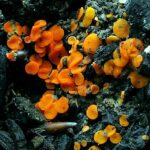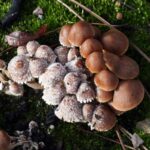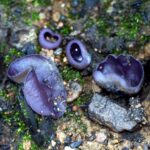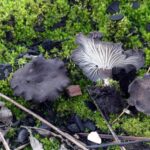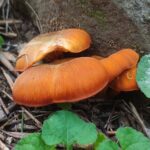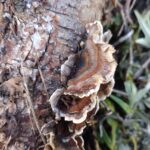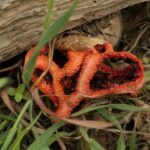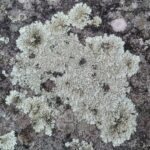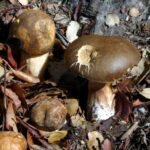Mushrooms were among the first pioneers to recolonize the Park after the terrible fire of September 2018.
Mushrooms are heterotrophic, obtaining nutrients through absorption, and play fundamental roles in maintaining environmental balance. Some are saprophytic, absorbing dead parts of other living organisms, thus contributing to decomposition and humus formation; others are parasites, exploiting other living beings to absorb the substances they need; others live in symbiosis. The two main types of symbiosis are mycorrhizae and lichens. Mycorrhizae are formed by the connection between fungal hyphae and plant roots. In this way, plants and fungi can exchange water, nutrients, and other substances. Lichens are formed by the union of a fungus with tiny autotrophic organisms (algae or cyanobacteria). The fungus can attach itself to any type of substrate and provides autotrophic organisms with protection, water, and minerals, while autotrophic organisms offer the fungus nutrients produced through photosynthesis. This allows lichens to colonize even bare rocks or metals!!
PIONEER FUNGI AFTER A FIRE
Usually, after a fire, the soil becomes enriched with potassium, magnesium, and phosphorus, and the latter continues to increase for a year and a half, while the other elements stabilize. By the third year, chemical and physical parameters typically return to pre-fire levels. Therefore, in the Park, typical post-fire species have gradually been replaced by classic species found in other Mediterranean scrub environments on acidic soils of Monte Pisano. There are various fungal species adapted to colonize fire-affected soils. Here are 4 species also found on Monte Pisano after the September 2018 fire (photos by Roberto Narducci).
Pulvinula carbonaria (Fukel) Boud, a nitrophilic species that develops small orange disc-shaped fruiting bodies and can also live parasitically on mosses.
Psathyrella pennata (Fr.) A. Pearson & Dennis, a carbonicolic species with a convex-campanulate cap ranging in color from gray-brown to reddish-brown with a lighter margin, covered by a cottony-felted white veil.
Peziza lobulata (Velen.) Svrček, a species with a violet fruiting body, lighter towards the margin and darker towards the center; initially cup-shaped, then flattening and becoming undulated and lobed.
Faerberia carbonaria (Alb. & Schwein.) Pouzar, an uncommon species that grows in small groups on charred woody remains; it has a cap of 3-5 cm in diameter, initially convex-umbilicate, then funnel-shaped with wavy and lobed margins; with a dry, felty-fibrillose, opaque surface in grayish-blue color, and whitish gills; the stem is cylindrical, fibrillose-tomentose, and gray-brown in color.
THE PARASITIC OR SAPROPHYTIC FUNGI
One of the most common fungi in the Park is the olive tree agaric (Omphalotus olearius (DC.) Singer) (photo by Andrea Moggi). As the name suggests, it is a species that usually lives in association with olive trees, either as a saprophyte or a parasite. The fruiting body appears in summer and autumn and is toxic. Sometimes it can be bioluminescent due to pigments present in its gills. The Park also hosts other saprophytic or parasitic fungi associated with plants affected by the fire, including Trametes versicolor (L.) Lloyd and Clathrus ruber P. Micheli ex Pers. Trametes versicolor (L.) Lloyd (photo by Roberta Sabelli) is a shelf fungus characterized by a fruiting body with a white or beige margin and concentric stripes of different colors ranging from orange and brown tones to blue and green tones, hence the specific epithet “versicolor.” Clathrus ruber P. Micheli ex Pers. (photo by Silvia Sorbi), commonly known as “devil’s fingers” or “red cage,” has a appearance reminiscent of a horror movie: a white gelatinous egg that tears open to reveal a red spongy mesh that encloses a grayish substance resembling brain matter. As it matures, the mesh develops and rises, and the gray substance decomposes, emitting a cadaverous odor. Its scientific name is derived from Latin and means “red lattice.”
SYMBIOTIC FUNGI
In addition to lichens (photo by Silvia Sorbi), which were the first colonizers of dry-stone walls and exposed rocks, the Park is also home to other symbiotic fungi such as the bay bolete (Boletus aereus Bull.) (photo by Roberto Narducci), which forms mycorrhizal associations with cork oak, holm oak, and downy oak on dry and siliceous soil. This edible fungus is characterized by a cap that can reach 20 cm in diameter, initially hemispherical, then convex, almost flat, with very dark colors ranging from brown to black, often with lighter patches; it has tubes that are initially white, then cream, and finally greenish at maturity, and a bulbous stem that is ochre-colored and darkens as it develops.
FREE MYCOLOGICAL CONSULTATION
The mycological consultation, free for all citizens, for the identification of collected mushrooms for edibility purposes, according to the procedures established by the Mycological Inspectorate of the Prevention Department of the North West Tuscany Health Authority (ATNO), is carried out at various local monitoring centers. For more information, visit: www.uslnordovest.toscana.it
To learn more, visit the website of the TUSCAN MYCOLOGICAL GROUPS ASSOCIATION (A. G. M. T.).

